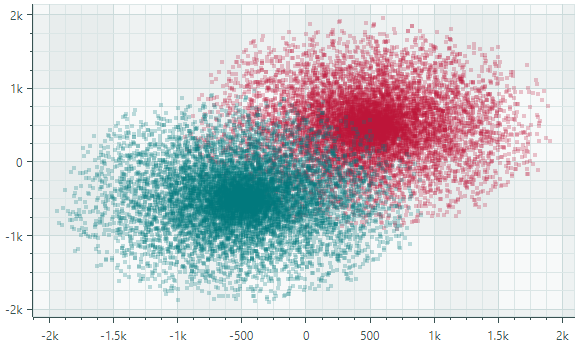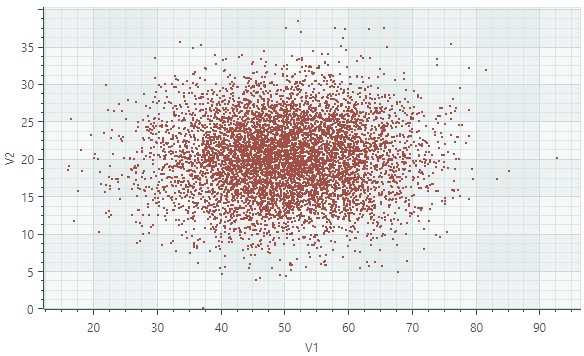Point Series View¶
The Point Series View (CartesianPointSeriesView) plots individual points. Each point is addressed by X and Y values. The following image shows a sample CartesianPointSeriesView that displays two series of scattered points, each painted in its own color.

Create a Point Series View¶
To create a Point Series View, add a CartesianSeries object to the CartesianChart.Series collection, and initialize the CartesianSeries.View with a CartesianPointSeriesView instance.
The following code shows how to create a Point Area Series View in XAML and code-behind.
<mxc:CartesianChart x:Name="chartControl">
<mxc:CartesianChart.Series>
<mxc:CartesianSeries Name="pointSeries1" DataAdapter="{Binding DataAdapter}" >
<mxc:CartesianPointSeriesView Color="Red" MarkerSize="2"/>
</mxc:CartesianSeries>
</mxc:CartesianChart.Series>
</mxc:CartesianChart>
CartesianSeries series = new CartesianSeries();
chartControl.Series.Add(series);
double[] args = new double[] {3,2,1,2,3,4,5,4 };
double[] values = new double[] { -1,0,1,2,3,2,1,0 };
// Use ScatterDataAdapter since points are not sorted by the X coordinate
series.DataAdapter = new ScatterDataAdapter(args, values);
series.View = new CartesianPointSeriesView()
{
Color = Avalonia.Media.Colors.Blue,
MarkerSize = 4,
};
Example - Use a Point Series View to Display a Cluster of Points¶
In this example, the Point Series View is used to display points randomly scattered along the numeric X and Y axes. Points in the source data series are not sorted by the X coordinate. To provide unsorted points to the Series View, the ScatterDataAdapter adapter is used.

<mx:MxWindow xmlns="https://github.com/avaloniaui"
xmlns:x="http://schemas.microsoft.com/winfx/2006/xaml"
xmlns:vm="using:ChartPointSeriesView.ViewModels"
xmlns:d="http://schemas.microsoft.com/expression/blend/2008"
xmlns:mc="http://schemas.openxmlformats.org/markup-compatibility/2006"
xmlns:mx="https://schemas.eremexcontrols.net/avalonia"
xmlns:mxc="https://schemas.eremexcontrols.net/avalonia/charts"
mc:Ignorable="d" d:DesignWidth="800" d:DesignHeight="450"
x:Class="ChartPointSeriesView.Views.MainWindow"
x:DataType="vm:MainWindowViewModel"
Icon="/Assets/EMXControls.ico"
Title="ChartPointSeriesView"
Width="600" Height="400">
<Design.DataContext>
<vm:MainWindowViewModel/>
</Design.DataContext>
<mxc:CartesianChart x:Name="chartControl">
<mxc:CartesianChart.Series>
<mxc:CartesianSeries Name="pointSeries1" DataAdapter="{Binding PointSeriesVM1.DataAdapter}" >
<mxc:CartesianPointSeriesView Color="{Binding PointSeriesVM1.Color}" MarkerSize="2"/>
</mxc:CartesianSeries>
</mxc:CartesianChart.Series>
<mxc:CartesianChart.AxesX>
<mxc:AxisX Name="xAxis" Title="V1" />
</mxc:CartesianChart.AxesX>
<mxc:CartesianChart.AxesY>
<mxc:AxisY Title="V2"/>
</mxc:CartesianChart.AxesY>
</mxc:CartesianChart>
</mx:MxWindow>
using CommunityToolkit.Mvvm.ComponentModel;
using Eremex.AvaloniaUI.Charts;
using System.Collections.Generic;
using System;
using Avalonia.Media;
using Avalonia;
namespace ChartPointSeriesView.ViewModels;
public partial class MainWindowViewModel : ViewModelBase
{
[ObservableProperty] SeriesViewModel pointSeriesVM1;
public MainWindowViewModel()
{
PointSeriesVM1 = new()
{
Color = Color.FromUInt32(0xffa24f46),
DataAdapter = GenerateRandomData()
};
}
private static Random random = new Random();
private static double GenerateNormalValue(double mean, double stdDev)
{
double u1 = 1.0 - random.NextDouble();
double u2 = 1.0 - random.NextDouble();
double randStdNormal = Math.Sqrt(-2.0 * Math.Log(u1)) * Math.Sin(2.0 * Math.PI * u2);
return mean + stdDev * randStdNormal;
}
public static ScatterDataAdapter GenerateRandomData()
{
int count = 7000;
double xMean= 50, xStdDev= 10, yMean = 20, yStdDev = 5;
List<double> args = new List<double>();
List<double> values = new List<double>();
for(int i = 0; i < count; i++)
{
double x = GenerateNormalValue(xMean, xStdDev);
double y = GenerateNormalValue(yMean, yStdDev);
args.Add(x);
values.Add(y);
}
return new ScatterDataAdapter(args, values);
}
}
public partial class SeriesViewModel : ObservableObject
{
[ObservableProperty] Color color;
[ObservableProperty] ScatterDataAdapter dataAdapter;
}
Data for the Point Series View¶
You can use the following data adapters to provide data for Point Series Views:
Numeric X Values:
FormulaDataAdapterScatterDataAdapterSortedNumericDataAdapter
Date and Time X Values:
SortedDateTimeDataAdapterSortedTimeSpanDataAdapter
Qualitative X Values:
QualitativeDataAdapter
Point Series View Settings¶
Color— Specifies the color used to paint the series.-
MarkerImage— Gets or sets an image to use as custom point markers. If no image is specified, default square-shaped markers are displayed. You can use anSvgImageclass instance to specify an SVG image.The
MarkerImageproperty is declared with the[Content]attribute, which allows you to define an image directly between the <CartesianPointSeriesView> tags.<mxc:CartesianPointSeriesView> <SvgImage Source="avares://Demo/Assets/circle.svg" /> </mxc:CartesianPointSeriesView>SVG files contain predefined colors for SVG elements. To make these colors match your data series color, you can either:
- Manually edit the source SVG image file beforehand
- Use the
MarkerImageCssproperty to dynamically customize styles for SVG elements. The styles are applied when point markers are rendered.
-
MarkerImageCss— Specifies CSS styles for runtime customization of an SVG image defined by theMarkerImageproperty. The primary use case is replacing SVG element colors with the series color (Color). Include the{0}placeholder to insert the value of theColorproperty in the CSS code.For example, when the
MarkerImageproperty contains an SVG image with a circle element, the following CSS code styles thecirclewith an Orange fill (using the series color) and Dark Red border:<mxc:CartesianPointSeriesView Color="orange" MarkerImageCss="circle {{fill:{0};stroke:darkred;}}"> <SvgImage Source="avares://Demo/Assets/circle.svg" /> </mxc:CartesianPointSeriesView>See also: Example - Create a Lollipop Series View and Use Custom SVG Markers.
-
MarkerSize— Specifies the size of point markers. ShowInCrosshair— Specifies the visibility of the crosshair chart label for the current series. See Customize Chart Labels of the Crosshair.